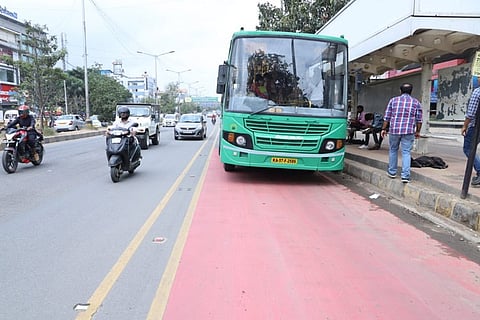

Despite some teething problems, the bus priority lanes which have been introduced in Bengaluru jointly by the BBMP, BMTC and Directorate of Urban Land Transport (DULT) in mid-November are showing early signs of success.
The idea behind bus lanes is to ensure priority access over private transport especially two-wheelers and in the process motivate people to ditch their own vehicles. This, in turn, is expected to reduce overall congestion in the city.
The Bangalore Traffic Police is expected to enforce the rule of only allowing BMTC (Bangalore Metropolitan Transport Corporation) buses in the left-most lanes of the roads chosen for this initiative. Violators are punished with a fine of Rs 500 for the first offence and Rs 1,000 for subsequent violations since December 1. Traffic police said that for the first 15 days, they tried to communicate the message to motorists and create awareness about the initiative.
Since November 15, the plan is only restricted to the 18.5 km stretch on the Outer Ring Road stretch between KR Puram Tin Factory to Silk Board. And a similar protocol is expected to be put in place for 12 other major roads in the city including the Hosur Road and Old Madras Road.
Car vs bus
Yogeesh Prabhuswamy, an activist with Citizens for Bengaluru, who works at Global Technology Park and a friend Ghanshyam who works at Prestige Tech Park compared the travel times of a bus and a car between KR Puram Tin Factory to the Kadubessanahalli Bus Stop for JP Morgan office on the Outer Ring Road over three days in peak hour traffic. What they realised was that it roughly took the same time in a bus or in a private car –around 30 minutes.
The two started from the same place and the same time between December 2 and 4, with Yogeesh taking the bus and Ghanshyam taking the car. Yogeesh said, “In fact, on the first day, the bus was faster than the car despite the bus having to wait at bus stops and give time for passengers to board and deboard. Moreover, the bus conductor often stops the bus to collect fares which can be avoided.”
Day 1 Starting time: 8:45 am
29m to Kadubesanahalli :)
— Yogeesh Prabhuswamy (@yogeeshgp) December 2, 2019
By clock Bus might have one but let's attribute it to error margin and call it 'Same time' - 30m :)
Because we also synced with call and we were there almost at same time ;) #BusPriorityLane with full force can be a clear winner :) @BMTC_Bangalore pic.twitter.com/azsWhzqSTc
Day 2 Starting time: 9:00 am
#BusPriorityLane #RaceDay 2 #BusVsCar Verdict - Tie again!
— Yogeesh Prabhuswamy (@yogeeshgp) December 3, 2019
~27m from KR puram rly-Kadubesanahalli(JPMorgan stop)@BMTC_BENGALURU @BBMPCOMM @blrcitytraffic @DULTBangalore @citizensforblr @BBPVedike @WFRising @BellandurJothge @srinualavilli @NammaBengaluroo @ghanshyam_in pic.twitter.com/a7ROyfpokU
Day 3 Starting time: 8:10 am
So its a tie again today, 3 in a row - #BusVsCar #RaceDay3 on #BusPriorityLane!
— Yogeesh Prabhuswamy (@yogeeshgp) December 4, 2019
*Bus would've won if it had not stopped 3m for issuing ticket - @BMTC_Bangalore Nodrappa olle chance missu :(
PS: We didn't time sync today. #Nimbus https://t.co/MGOfqU0axd pic.twitter.com/IT1AJhUu8G
Yogeesh added, “While there is a lot of improvement expected with the authorities creating barricades restricting vehicles entering the lanes midway, a lot can be done by the traffic police.”
There have been multiple instances of road users complaining of an unabated violation of the rule due to the lack of effective enforcement. On this, Yogeesh insisted just by manning only places near bus stops or where there is flyover down ramps, the system can be made more efficient in the short term.
Another issue that Yogeesh pointed was the lack of awareness and signage created by the authorities to inform the road users.
BMTC staff also conceded that the system is yet to be finetuned to perfection.
Nagaraj Murthy BS, Division Controller for Central Division, said, “So far we are only seeing 10 minutes of average travel time reduction in the entire stretch. This is due to other vehicles entering the bus lanes as there are no physical barricades. But soon with greater awareness and enforcement, we are confident of bringing down the travel time by more than 30 minutes and more. We plan to run more than 450 Volvo buses in this stretch alone.”
He added, “Once we establish a consistent pattern of travel times, we will form a timetable. This coupled with the upcoming real-time bus tracking app will make BMTC much more reliable and user-friendly.”